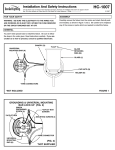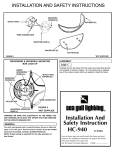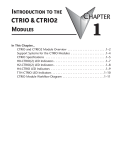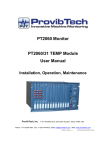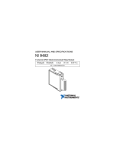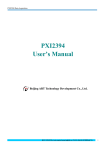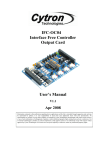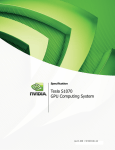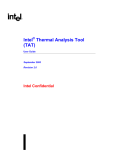Download High-Speed Counter
Transcript
High-Speed Counter I/O Module CTRIO features HIgh-Speed Counter I/O Module T1H-CTRIO <---> Overview The High-Speed Counter I/O (CTRIO) module is designed to accept high-speed pulse-type input signals for counting or timing applications and to provide highspeed pulse-type output signals for stepper motor control, monitoring, alarm or other discrete control functions. The CTRIO module offers great flexibility for applications that call for precise counting or timing, based on an input event or for high-speed control output applications. The CTRIO module has its own microprocessor and operates asynchronously with respect to the PLC/controller. This means that the on-board outputs respond in real time to incoming signals, so there is no delay waiting for the PLC/Controller to scan I/O. The CTRIO modules offer the following I/O features: • Eight DC sink/source inputs, 9-30 VDC • Four isolated sink/source DC outputs, 5-30 VDC, 1A per point Inputs supported: • Two quadrature encoder counters up to 100 kHz, or four single-channel counters up to 100 kHz using module terminals Ch1A, Ch1B, Ch2A and Ch2B • High-speed edge timers, dual edge timers, pulse catch, count reset, count inhibit , or count capture or home search limits using module terminals Ch1C, Ch1D, Ch2C or Ch2D Outputs supported: • Four independently configurable highspeed discrete outputs or two channels pulse output control (20 Hz-25 kHz per channel or 50 kHz if only using one channel) • Pulse and direction or cw/ccw pulses supported for pulse output control • Raw control of discrete output directly from user control program Software configuration All scaling and configuration is done via CTRIO Workbench, a Windows software utility program. This eliminates the need for PLC ladder programming or other interface device programming to set up the module. CTRIO Workbench runs under Windows 98/2000/XP and NT 4.0 SP5 or later. CTRIO Workbench main configuration screen PLC Overview Typical applications • High-speed cut-to-length operations using encoder input • Pick-and-place or indexing functions controlling a stepper drive • Dynamic registration for web material control • Accurate frequency counting for speed control with onboard scaling • PLS (Programmable Limit Switch) functions for high-speed packaging, gluing, or labeling • Sub 10 µsec pulse-catch capability for high-speed product detection • Functions for level or flow Supported systems Multiple T1H-CTRIO modules can reside in the same I/O system provided that the base power budget is adequate. PC-based Ethernet I/O control systems DL105 PLC DL205 PLC DL305 PLC DL405 PLC Field I/O Software C-more HMIs Other HMI AC Drives Motors The T1H-CTRIO module can be used in PC-based control systems using the T1H-EBC(100) interface module. Steppers/ Servos Motor Controls Profibus systems Proximity Sensors The T1H-CTRIO module can be used in Profibus systems using the T1H-PBC slave interface module. Photo Sensors ERM to EBC systems Limit Switches The T1H-CTRIO module is supported in T1H-EBC(100) slaves in H*-ERM systems. Encoders Notes: Process 1. The T1H-CTRIO module is not supported in T1K-RSSS serial remote I/O bases. The H2-CTRIO module is designed to work with incremental encoders or other field devices that send pulse outputs. DL05/06 PLC 2. System functions are not available when CTRIO is used in ERM/EBC expansion I/O. Pushbuttons/ Lights Relays/ Timers Comm. TB’s & Wiring Power Enclosures Appendix Part Index Use Configure I/O dialog to assign the CTRIO input and output functions w w w. a u to m at i o n d i re c t . c o m / f i e l d I O Universial Field I/O 7–27 High-Speed Counter I/O Specifications General Module Type Modules Per Base I/O Points Used Field Wiring Connector Internal Power Consumption Operating Environment Manufacturer Isolation Intelligent Limited only by power consumption None, I/O map directly in PLC V-memory or PC control access Standard removable terminal block 400 mA Max at +5V from Base Power Supply, Maximum of 6 Watts (All I/O in ON State at Max Voltage/Current) 32°F to 140°F (0°C to 60°C), Humidity (non-condensing) 5% to 95% Host Automation Products, LLC 2500 V I/O to Logic, 1000 V among Input Channels and All Outputs T1H-CTRIO Input Specifications Inputs Minimum Pulse Width Input Voltage Range Maximum Voltage Input Voltage Protection Rated Input Current Minimum ON Voltage Maximum OFF Voltage Minimum ON Current Maximum OFF Current OFF to ON Response ON to OFF Response T1H-CTRIO Output Specifications 8 pts sink/source Outputs 4 pts, independently isolated, current sourcing or sinking FET Outputs: open drain and source with floating gate drive 5 µsec Voltage Range Maximum Voltage Output Clamp Voltage Maximum Load Current Maximum Load Voltage Maximum Leakage Current Inrush Current OFF to ON Response ON to OFF Response ON State V Drop External Power Supply Overcurrent Protection Thermal Shutdown Overtemperature Reset Duty Cycle Range Configurable Presets a) single b) multiple 5 VDC - 36 VDC 36 VDC 60 VDC 1.0 A 9-30 VDC 30 VDC Zener Clamped at 33 VDC 8 mA typical 12 mA maximum 9.0 VDC 2.0 VDC 5.0 mA (9 VDC required to guarantee ON state) 2.0 mA Less than 3 µsec Less than 3 µsec 36 VDC 100 µA 5 A for 20 ms Less than 3 µsec Less than 3 µsec 0.3 V For loop power only, not required for internal module function* 15 A max Tjunction = 150°C Tjunction = 130°C 1% to 99% in 1% increments (default = 50%) a) Each output can be assigned one preset, or b) Each output can be assigned one table of presets, one table can contain max. 128 presets, max. predefined tables = 255 * User supplied power source required for stepper drive configuration. T1H-CTRIO Input Resources (2 per 4 input channel group) Counter/Timer 4, up to 100 kHz 1X, 2X, or 4X Quadrature, Up or Down Counter, Edge Timer, Dual Edge Timer, Input Pulse Catch, Reset, Inhibit, Capture Resource Options Timer Range / 4.2 billion (32 bits); 1 µsec Resolution Counter Range 7–28 T1H-CTRIO Output Resources Pulse output / Discrete outputs Pulse outputs: 2 channels (2 outputs each channel) Discrete outputs: 4 pts. Resource Options Pulse outputs: pulse/direction or cw/ccw; Profiles:Trapezoid, S-Curve, Symmetrical S-Curve, Dynamic Position, Dynamic Velocity, Home Search, Velocity Mode, Run to Limit Mode and Run to Position Mode Discrete outputs: 4 configurable for set, reset, pulse on, pulse off, toggle, reset count functions (assigned to respond to Timer/Counter input functions). Raw mode: Direct access to discrete output from user application program Target Position Range ± 2.1 billion (32 bits or 31 bits + sign bit) ± 2.1 billion (31 bits + sign bit) Universial Field I/O 1 - 80 0 - 633 - 0405 High-Speed Counter PLC Overview DL05/06 PLC Status indicators T1H-CTRIO LED Descriptions OK ER 1A - 1D 2A - 2D CH1 CH2 Y0 - Y3 DL105 PLC T1H-CTRIO- LED Diagnostic Definitions Module OK LED OK LED ER DL205 PLC Description User Program Error ON OFF All is well - RUN Mode Ch1A - Ch1D Input Status ON ON Hardware Failure Ch2A - Ch2D Input Status Blinking Blinking Channel 1 Status Blinking OFF Channel 2 Status OFF Blinking Output Status OFF ON Module Error Due to Watchdog Timeout OFF OFF No Power to Module DL305 PLC Boot Mode - Used for Field OS Upgrades DL405 PLC Program Mode Module Self-diagnostic Failure Field I/O Software T1H-CTRIO LED Diagnostic Definition CH1 CH2 Y0 - Y3 C-more HMIs Blinks when Channel 1 Function 1 is counting or timing Blinks when Channel 2 Function 1 is counting or timing Other HMI Follow actual output state; ON = output is passing current Installation and wiring AC Drives The T1H-CTRIO module has two independent input channels, each consisting of four optically isolated input points (points 1A-1D on common 1M and points 2A-2D on common 2M). The inputs can be wired to either sink or source current. The module has four optically isolated output points (points Y0-Y3 on isolated commons C0-C3, respectively). The outputs must be wired so that positive current flows into the Cn terminal and then out of the Yn terminal (see the diagram below and the schematic on the following page). The module is configured, using CTRIO Workbench, to accommodate the user’s application. The function of each input (counting, timing, reset, etc.) and output (pulse output, discrete output, etc.) is defined in the configuration of the module. See the notes below for further details about power source considerations, circuit polarities, and field devices. 1B 1C 1D Y0 Y0 Y1 Y1 2A 2B 2C Steppers/ Servos Motor Controls Proximity Sensors Photo Sensors Limit Switches Input / Output Channels 1A Motors 2D Y2 Y2 Y3 Encoders Y3 T1H–CTRIO Pushbuttons/ Lights OK ERR CH1 CH2 Channel Commons 1M 1M 1M 1M C0 C0 C1 C1 2M 2M 2M Process 2M C2 C2 C3 C3 1A 1B 1C 1D Y0 Y1 2A 2B 2C 2D Y2 Y3 Relays/ Timers 2 Comm. User Bus Terminals (no internal connection to CTRIO) –––––––USER BUS 1––––––– TB’s & Wiring –––––––USER BUS 2––––––– Power Notes: 1. Inputs (1A, 1B, 1C, 1D and 2A, 2B, 2C, 2D) require user-provided 9-30 VDC power sources. Terminals 1M and 2M are the commons for Channel 1 and Channel 2 inputs. Maximum current consumption is 12 mA per input point. 2. Polarity of the input power sources can be reversed. Consideration must be given, however, to the polarity of the field device. Many field devices are designed for only one polarity and can be damaged if power wiring is reversed. 3. Outputs have one polarity only and are powered by user-provided 5-36 VDC power sources. The maximum allowable current per output circuit is 1A. 4. User Bus 1 and User Bus 2 are independent 8-wire terminal buses. They can be used for additional power rail connections. w w w. a u to m at i o n d i re c t . c o m / f i e l d I O Universial Field I/O 7–29 Enclosures Appendix Part Index High-Speed Counter Solid state input wiring device Pulse output schematic DC types of field devices are configured to either sink or source current. This affects the wiring of the device to the CTRIO module. Refer to the sinking/sourcing section of the appendix in this catalog for a complete explanation of sinking and sourcing concepts. Cn (where n=0, 1, 2, 3) CTRIO Output +5 to 36 VDC Yn + Load - NPN Field Device (sink) + This drawing illustrates wiring that is typical for Channel 1 terminals 1A, 1B, 1C, and 1D. The same circuitry is also present at the corresponding Channel 2 terminals. Load +5 to 36 VDC Cn (where n=0, 1, 2, 3) 1A Sensing Circuit CTRIO Output Yn 24 - VDC + 1M The same circuitry is present at the corresponding Channel 2 terminal. Stepper/servo drive wiring example 24 VDC PNP Field Device (source) This drawing illustrates wiring that is typical for Channel 1 terminals 1A, 1B, 1C, and 1D. The same circuitry is also present at the corresponding Channel 2 terminals. + - Input / Output Channels 1A Sensing Circuit 1B 1C 1D Y0 Y0 Y1 Y1 2A 2B 2C 2D Y2 Y2 Y3 Y3 Step Amplifier 1A Step Amplifier 5-36 VDC - + 5-36 VDC OPTO Power Pulse Channel Commons + - Pulse (or CW) 1M 1M 1M 1M C0 C0 C1 C1 2M 2M 2M OPTO Power 2M C2 C2 C3 C3 (or CW) Direction (or CCW) Direction (or CCW) User Bus Terminals (no internal connection to CTRIO) –––––––USER BUS 1––––––– –––––––USER BUS 2––––––– 1M The same circuitry is present at the corresponding Channel 2 terminal. 7–30 Universial Field I/O 1 - 80 0 - 633 - 0405 High-Speed Counter PLC Overview CTRIO Workbench configure I/O setup Fill-in-the-blank configuration software The CTRIO Workbench is the software utility used to configure the CTRIO module and to scale signals to desired engineering units. Workbench also allows you to perform various other functions, such as switching between the CTRIO’s Program mode and Run mode, monitoring I/O status and functions, and diagnostic control of module functions. The CTRIO Workbench utility ships with the CTRIO User Manual. You can also download the latest version free at the Host Automation Products, L.L.C. Web site: www.hosteng.com. The Configure I/O dialog is the location where input and output functions are assigned to the module. The choice of input and output functions determines which options are available. The input function boxes prompt you with selections for supported functions. The Workbench software automatically disallows any unsupported configurations. DL05/06 PLC DL105 PLC DL205 PLC DL305 PLC DL405 PLC Field I/O CTRIO Workbench main configuration screen Software C-more HMIs Select modules from multiple networked PLCs Other HMI T1H-CTRIO Save and load configurations with Read/Write File feature AC Drives Configure I/O screen Motors Steppers/ Servos Motor Controls Proximity Sensors Detailed snap-shot of module status and configurations Photo Sensors CTRIO Workbench diagnostics and monitoring The Monitor I/O dialog is accessible from the main Workbench dialog when the module is in Run Mode. This allows for a convenient way to test and debug your configuration prior to installation. The Monitor I/O dialog is divided into three functional areas: Input Functions, Output Functions and System Functions. The data displayed under the Input Functions tab includes all input Dword parameters, status bits and the current status of each configured input and output function. The fields displayed under the Output Functions tab includes all output Dword parameters and configuration information that can be altered during runtime and the bits that indicate successful transfers or errors. The System Functions can be used to read from or write to the CTRIO’s internal registers. Monitor I/O screen Limit Switches Encoders CTRIO Workbench on-board scaling Scaling raw signals to engineering units is accomplished using the Scaling Wizard. The Scaling Wizard options are different for the Counter functions as compared with the Timer functions. “Position” and “Rate” scaling are available when you select a Counter function. “Interval” scaling is available when you select a Timing function. Pushbuttons/ Lights Process Relays/ Timers Comm. TB’s & Wiring Scaling Wizard screen Power Monitor I/O dialog included for easy de-bug features Enclosures Appendix Part Index w w w. a u to m at i o n d i re c t . c o m / f i e l d I O Universial Field I/O 7–31 High-Speed Counter High-speed counting High-speed input operations The CTRIO can be configured for counting functions for the use of an encoder input, (up to two quadrature encoders per module) with available connections for external reset and inhibit signals. In a simple cut to length application as shown, the encoder provides an input position reference for the material to the module. The module's high speed outputs are wired to the cutting device and to the clutch and/or braking device. When the count from the encoder is equal to a preprogrammed setpoint within the module, the high speed outputs are activated to stop and cut the material to a repeatable fixed length. Additionally, the clutch/brake signal can be used for an inhibit signal to not accumulate counts while the material is being cut. The CTRIO module is capable of a wide variety of high speed input and output operations all within one module. With its flexible 2-channel input and separate 2-channel output design, the CTRIO can satisfy both high-speed counting, timing, pulse catch operations, along with high speed discrete output or several profile choices of pulse output operations. Not all combinations of input functions and output functions are possible within the resources of the module, but the following examples are some of the most common applications for the CTRIO. Check out these examples and see how they relate to your high speed application needs. High-speed timing The CTRIO can be configured for timing functions based on both count or rate. Using a common configuration of a proximity switch sensing the teeth on a gear, the module is able to calculate the velocity of the gear based on the rate it receives its counts. This value can be scaled within the module to the engineering units required for the application. High-speed cut-to-length application Interface device with CTRIO module Motor Interface Motor control lines Gearbox, clutch and brake interface CTRIO high speed output High-speed timing application Interface device with CTRIO module Encoder Cutter interface Cutter assembly Material to be cut to length Gear Proximity switch Photoelectric switch Using Configure I/O screen to configure CTRIO for high-speed counting Using Configure I/O screen to configure CTRIO for high-speed timing Point-click selections of hardwired connection for Counting, Reset, and Inhibit Powerful edge timing functions clicking on the edge button cycles through the available edge timing functions 7–32 Universial Field I/O 1 - 80 0 - 633 - 0405 High-Speed Counter PLC Overview Pulse output operations DL05/06 PLC Interface device with CTRIO module DL105 PLC Using Edit Pulse Profile screen to select Trapezoid pulse output profile DL205 PLC DL305 PLC CTRIO pulse output signals Fill spout DL405 PLC Field I/O Software Stepper or servo drive C-more HMIs Fill-in-the-blank parameters allow precise tuning of the pulse output profile Pulse output for stepper/servo control The CTRIO module is capable of multiple configurations for pulse output control, most often when connected to a stepper or servo drive system. The module can deliver a pulse output signal up to a maximum of 25 kHz on two channels with support for pulse-anddirection or CW/CCW pulses. The available profile choices include Trapezoid, S-Curve, Symmetrical S-Curve, Dynamic Positioning, and Pulse to Limit. All profiles can be easily configured using the CTRIO Workbench software with fill-in-the-blank parameter fields and a graphic representation of the selected profile. Three additional profiles are available that are completely controlled by the user program (no CTRIO profile is configured). They are Velocity Mode, Run to Limit Mode and Run to Position Mode. Example application In a simple rotary indexing application, as shown above, a fixed Trapezoid profile is chosen. The CTRIO for this application is wired to a stepper drive for pulse-and-direction. The requirement for this application is to provide a smooth movement of the rotary table to allow product to be filled into individual containers equal distance apart. The predetermined number of pulses required for each movement is entered into the CTRIO Workbench as "Total Pulses" along with the Starting Frequency, Ending Frequency, and Positioning Frequency (speed after acceleration). The Acceleration and Deceleration parameters are entered in units of time, so no ramp-distance calculations are required. After all parameters are entered, a graphical representation of the configured profile is shown automatically. Once the configuration has been downloaded to the module, all that is needed from the PLC CPU is the Enable Output signal to begin a movement. Stepper motor inside housing Circular turn table Other HMI AC Drives Rotary indexing liquid fill application Other common pulse output applications: • S-Curve accel/decel profile for signaling a stepper or servo drive that needs a curved acceleration and deceleration pro file, i.e. for diminishing any initial “jerk” upon movement of static products, boxes on conveyors, liquids in containers on an indexer, printing registrations, etc. • Dynamic Positioning for any run-to-a-specific-position requirement, either by a pre-programmed count of an external high speed discrete input wired to the module. This is popular in winding or webcontrol with any dynamic registration mark or variable speed requirement. • Home Search routines to seek a home position based on CTRIO discrete input limit(s). Motors Steppers/ Servos Motor Controls Proximity Sensors Photo Sensors Limit Switches Encoders Pushbuttons/ Lights Process Example of S-Curve acceleration and deceleration pulse output profile Relays/ Timers Comm. TB’s & Wiring Power Enclosures Appendix Part Index Calculate Profile displays graphical representation of pulse output profile w w w. a u to m at i o n d i re c t . c o m / f i e l d I O Universial Field I/O 7–33 High-Speed Counter Multihead drill machine application Combining high-speed input and pulse output operations Using CTRIO Workbench to configure the module for simultaneous high-speed input and high-speed pulse output operation Proximity switch Proximity switch Proximity switch Encoder Stepper or servo drive Interface device with CTRIO module High-Speed inputs and pulse output combinations The flexible design of the CTRIO module allows for combining high speed inputs and delivering high speed pulse outputs signals simultaneously. There are limitations to this type of configuration in that the module does not internally support closed loop control. Providing closed loop control with the CTRIO involves additional PLC code to coordinate this control, making the application subject to the PLC CPU program scan. Simple position/speed monitoring, via a high speed counting input for non-critical response while providing pulse outputs to a drive, is easily achievable for the CTRIO. Master Controller program Example application In the simple drill-head application shown above, the CTRIO pulse outputs are wired to a stepper and/or servo drive. The inputs are wired to an encoder attached to the lead screw on the movable portion of the drill-head assembly. The CTRIO module output pulse train to the drive allows the motor to spin the lead screw making the drill move forward into the passing material. The encoder monitors the speed and position of the drill-head. Prox switches at each end act as limit switches ensuring the drill-head will not over-travel. A home sensor is positioned in the middle of the assembly, allowing the PLC to reset the count. CTRIO pulse output profile Note: Closed loop control for the CTRIO module requires control program interaction to close the loop. This makes the application subject to the master controller scan. CTRIO high-speed input pulse train 7–34 Universial Field I/O 1 - 80 0 - 633 - 0405









